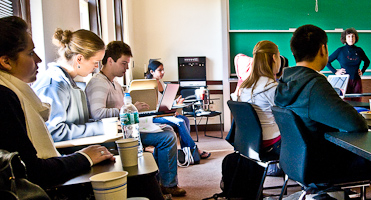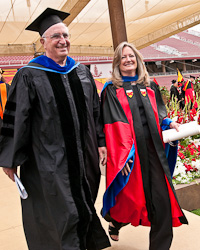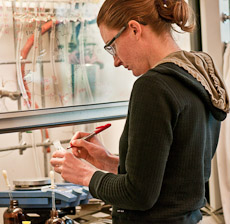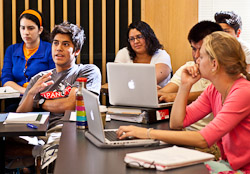Giving Priorities
STANFORD ARTS 2016

During the last five years, Stanford has undergone an important cultural shift that has expanded and deepened opportunities in the arts. Today, that momentum continues and, by 2016, a dynamic new arts hub will redefine the main gateway to campus.
Anchored by the Iris & B. Gerald Cantor Center for Visual Arts, an arts district is taking shape with the opening of Bing Concert Hall. The Anderson Collection at Stanford University—one of the world’s preeminent collections of post-World War II American art—is set to open in 2014.
The McMurtry Building, the new home for the Department of Art & Art History, will bring together programs in art practice, art history, film and design under one roof for the first time when it opens in 2015.
At Stanford, we believe that art fundamentally enriches human experience and encourages students, faculty, and the broader community to experience the world in new ways. As we move forward, Stanford is poised to define what it means to make, experience, and study art in the 21st century.
Learn more about supporting The Arts at Stanford.
GLOBALIZING THE CURRICULUM

Since Stanford was established in 1891, globalization of the academic marketplace has changed the profile of the university’s student body. Today, almost one-fifth of Stanford undergraduates and more than two-fifths of graduate students are born outside the United States. In response to a globalizing world, an H&S education must prepare students to engage with emerging issues as well as established ones.
A Stanford education must offer expanded opportunities to learn about South Asia, the Middle East, and the Far East, as well as subjects that transcend geographic boundaries. This means increasing courses on international issues in a variety of disciplines, as well as broadening language instruction and expanding opportunities to live and study overseas.
Support for Globalizing the Curriculum is key to fulfilling the Stanford family’s promise of a useful, well-rounded education.
ENDOWED PROFESSORSHIPS

The excellence of any university depends on its faculty. Endowed professorships are the highest honor H&S can bestow upon faculty who have made extraordinary contributions to research and teaching. They also enable Stanford to offer competitive compensation packages in recruiting scholars who are in high demand around the country and the world.
The scholars who hold endowed professorships represent the most distinguished faculty members of their generation. An endowed chair is the most important contribution one can make to academic and intellectual independence. It is a legacy that benefits H&S and Stanford as a whole.
GRADUATE FELLOWSHIPS

A university would not be a stimulating or productive environment without the contributions made by graduate students. A critical mass of graduate students is required to sustain Stanford’s academic vitality.
These young scholars push their disciplines in new directions by challenging existing beliefs and encouraging the flow of ideas. They mentor and teach undergraduates, and play a key role in retaining top faculty.
Graduate fellowships are an important reason students—and their professors—come to and stay at Stanford. Fellowships support the next generation of innovators and leaders whose ideas can change the world.
Fellowships are particularly critical in the natural sciences, where research is time-consuming and expensive. Graduate students pursuing innovative research across traditional disciplines face growing challenges in securing support. The unpredictability of government funding makes support for these fellowships more important than ever.
UNDERGRADUATE EDUCATION

The School of Humanities and Sciences awards nearly 80 percent of undergraduate degrees and represents the core of a Stanford education. The school aims to deliver a transformative educational experience, one that encourages critical thinking and risk-taking.
Stanford’s special niche in the world of undergraduate education is offering the intimacy of a liberal arts education within a leading research institution. Here, students interact daily with faculty who are also preeminent scholars in their fields.
Support for undergraduates translates into smaller class sizes and greater possibilities for student-teacher dialogue. It allows more students to pursue independent research, a cornerstone of academic achievement at Stanford. And it offers promising young students unequaled opportunities for learning inside and outside the classroom.

